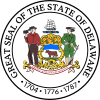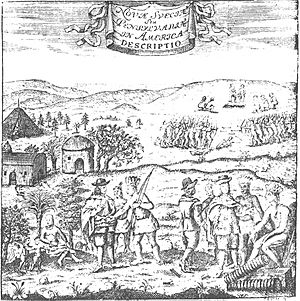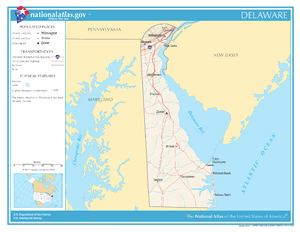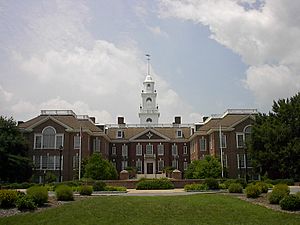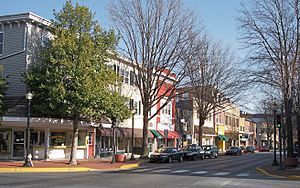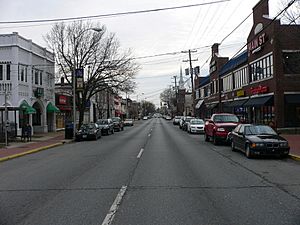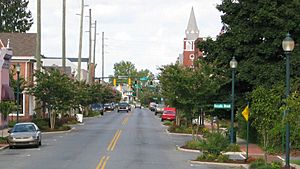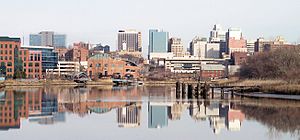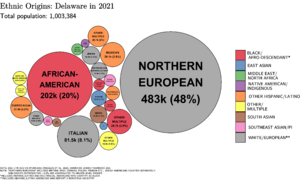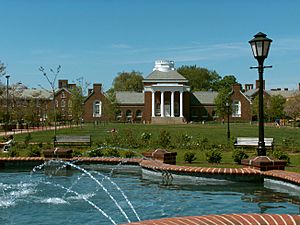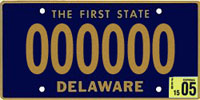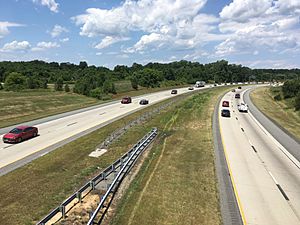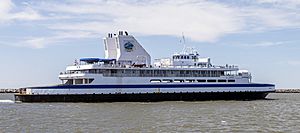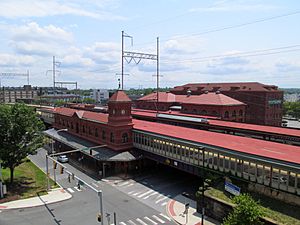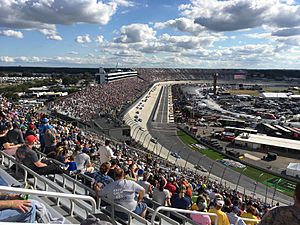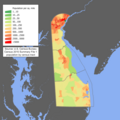Delaware facts for kids
Quick facts for kids
Delaware
|
|||
|---|---|---|---|
|
|||
| Nickname(s):
The First State; The Small Wonder; Blue Hen State; The Diamond State
|
|||
| Motto(s): | |||
| Anthem: "Our Delaware" | |||
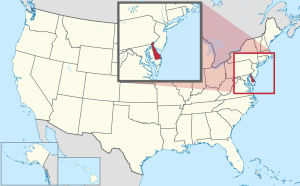
Location of Delaware within the United States
|
|||
| Country | United States | ||
| Before statehood | Delaware Colony, New Netherland, New Sweden | ||
| Admitted to the Union | December 7, 1787 (1st) | ||
| Capital | Dover | ||
| Largest city | Wilmington | ||
| Largest county or equivalent | New Castle | ||
| Largest metro and urban areas | Delaware Valley | ||
| Legislature | General Assembly | ||
| • Upper house | Senate | ||
| • Lower house | House of Representatives | ||
| Judiciary | Delaware Supreme Court | ||
| U.S. senators | Chris Coons (D) Lisa Blunt Rochester (D) |
||
| U.S. House delegation | Sarah McBride (D) (list) | ||
| Area | |||
| • Total | 2,489 sq mi (6,450 km2) | ||
| Area rank | 49th | ||
| Dimensions | |||
| • Length | 96 mi (154 km) | ||
| • Width | 30 mi (48 km) | ||
| Elevation | 60 ft (20 m) | ||
| Highest elevation
(Near the
Ebright Azimuth) |
447.85 ft (136.50468 m) | ||
| Lowest elevation
(Atlantic Ocean)
|
0 ft (0 m) | ||
| Population
(2024)
|
|||
| • Total | |||
| • Rank | 45th | ||
| • Density | 491/sq mi (190/km2) | ||
| • Density rank | 6th | ||
| • Median household income | $81,400 (2023) | ||
| • Income rank | 19th | ||
| Demonym(s) | Delawarean | ||
| Language | |||
| • Official language | None | ||
| Time zone | UTC−05:00 (EST) | ||
| • Summer (DST) | UTC−04:00 (EDT) | ||
| USPS abbreviation |
DE
|
||
| ISO 3166 code | US-DE | ||
| Traditional abbreviation | Del. | ||
| Latitude | 38° 27′ N to 39° 50′ N | ||
| Longitude | 75° 3′ W to 75° 47′ W | ||
| Bird | Delaware Blue Hen |
|---|---|
| Fish | Weakfish |
| Flower | Peach blossom |
| Tree | American holly |
| Insect | 7-spotted ladybug |
Delaware is a state located in the Mid-Atlantic and Northeastern parts of the United States. It shares borders with Maryland to the south and west, Pennsylvania to the north, New Jersey to the northeast, and the Atlantic Ocean to the east. The state is named after the nearby Delaware Bay, which got its name from Thomas West, 3rd Baron De La Warr. He was an English nobleman and the first governor of the Colony of Virginia.
Delaware is on the northeastern part of the Delmarva Peninsula. It also includes some islands and land within the Delaware River. It is the second smallest state by area and the sixth least populated. However, it is also the sixth most densely populated state. The largest city in Delaware is Wilmington. Its capital is Dover, which is the second largest city.
The state is divided into only three counties, which is the fewest of any U.S. state. From north to south, they are New Castle County, Kent County, and Sussex County. The southern counties, Kent and Sussex, have historically been farming areas. New Castle County is more urban and is part of the Delaware Valley area around Philadelphia. Delaware's culture and history mix elements from the Mid-Atlantic and Northeastern regions.
Before Europeans arrived in the 16th century, Native American tribes lived in Delaware. These included the Lenape in the north and the Nanticoke in the south. The first European settlers were Dutch traders in 1631 at Zwaanendael, near today's Lewes, Delaware. Delaware was one of the Thirteen Colonies that fought in the American Revolutionary War. On December 7, 1787, Delaware was the first state to approve the Constitution of the United States. This is why it is called "The First State."
Since the early 1900s, Delaware has become a popular place for companies to set up their legal base. Its corporate laws are very attractive to businesses. More than half of all companies listed on the New York Stock Exchange are legally based in Delaware.
Contents
- What Does "Delaware" Mean?
- A Look at Delaware's Past
- Delaware's Landscape
- How Delaware is Governed
- Cities and Towns
- Who Lives in Delaware?
- Delaware's Economy
- Media and News
- Fun Things to Do in Delaware
- Learning in Delaware
- Getting Around Delaware
- Sports and Fun
- Delaware's International Connections
- Famous People from Delaware
- Images for kids
- See also
What Does "Delaware" Mean?
The state of Delaware was named after the Delaware River. The river, in turn, was named after Thomas West, 3rd Baron De La Warr. He was the governor of the Colony of Virginia when Europeans first explored the river. The Lenape people, who lived in the Delaware Valley, were also called the "Delaware Indians" by Europeans. Their name also comes from the same source.
A Look at Delaware's Past
Early Native American Life
Before European colonists settled in Delaware, the area was home to two main Algonquian tribes. The Unami Lenape lived throughout the Delaware Valley. The Nanticoke lived along the rivers that flow into the Chesapeake Bay.
The Unami Lenape had a settled way of life, combining hunting with farming. They became important in the fur trade with other tribes. By the mid-1700s, many Lenape who wanted to keep their traditions moved west over the Allegheny Mountains.
Colonial Times in Delaware
The Dutch were the first Europeans to settle in Delaware. They built a trading post called Zwaanendael near Lewes, Delaware in 1631. Sadly, all the settlers were killed within a year in a conflict with local Native American tribes.
In 1638, New Sweden, a Swedish colony, was started at Fort Christina (now in Wilmington). This colony included Swedes, Finns, and Dutch settlers. New Sweden lasted for 17 years.
In 1651, the Dutch built a fort at what is now New Castle, Delaware. By 1655, they took over the New Sweden colony, making it part of their New Netherland territory. Just nine years later, in 1664, the English took control from the Dutch. James, the Duke of York, then gave his ownership to William Penn in 1682. Penn wanted access to the sea for his Pennsylvania province. He leased the area, which became known as the "Lower Counties on the Delaware."
Penn created a representative government. For a short time, he combined Pennsylvania and the Lower Counties under one government. However, by 1704, Pennsylvania had grown so much that its representatives wanted to make decisions on their own. So, the two groups of representatives began meeting separately. Penn and his family remained the owners of both areas. They always appointed the same person to be governor for both Pennsylvania and the Lower Counties.
Delaware and the American Revolution
Delaware played an important role in the American Revolution. The state provided a strong military group called the "Delaware Blues." They were also known as the "Blue Hen's Chicks." In August 1777, the British army, led by General Sir William Howe, marched through Delaware. They were on their way to the Battle of Brandywine and to capture Philadelphia. The only real battle fought in Delaware was the Battle of Cooch's Bridge. This happened on September 3, 1777, in New Castle County.
Slavery and Social Change
Many early settlers in Delaware came from Maryland and Virginia. These colonies relied heavily on enslaved labor for farming. In the early days, the difference between indentured servants (who worked for a set time to pay for their travel) and enslaved Africans was not always clear. Over time, as fewer indentured workers arrived, more enslaved people were brought in.
Towards the end of the colonial period, the number of enslaved people in Delaware began to decrease. Even though efforts to completely end slavery in the state failed by a small number of votes, the practice had mostly ended in reality. Delaware is unique because it was the only state where slavery was legal that did not form any groups to fight for the Confederacy during the American Civil War. Delaware officially ended slavery shortly after the Civil War. It later approved the 13th, 14th, and 15th Amendments to the U.S. Constitution in 1901. These amendments ended slavery, granted citizenship, and gave voting rights to African American men.
Delaware's Landscape
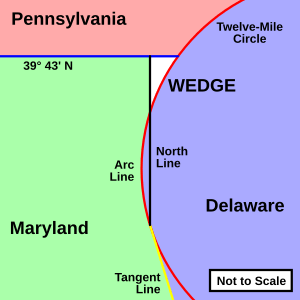
Delaware is about 96 miles (154 km) long and ranges from 9 miles (14 km) to 35 miles (56 km) wide. It covers a total of 1,954 square miles (5,060 km2). This makes it the second-smallest state in the United States, after Rhode Island. Delaware's northern border touches Pennsylvania. To the east, it is bordered by the Delaware River, Delaware Bay, New Jersey, and the Atlantic Ocean. To the west and south, it borders Maryland.
A small part of Delaware is also on the eastern side of the Delaware River, sharing land with New Jersey. The state of Delaware, along with parts of Maryland and Virginia, forms the Delmarva Peninsula.
The northern boundary of Delaware is quite unusual. Most of the border with Pennsylvania was originally drawn as a circle. This circle extends 12 miles (19.3 km) from the center of the courthouse in New Castle. This border even reaches the low-tide mark on the New Jersey shore. A small piece of land called "The Wedge" was claimed by both Delaware and Pennsylvania until 1921, when Delaware's claim was confirmed.
Delaware's Weather
Because most of Delaware is close to the ocean, its climate is milder. The state has a humid subtropical climate. Even though it's a small state, there are differences in temperature and snowfall between the northern and southern parts. The southern part, influenced by the Atlantic Ocean and Delaware Bay, has milder weather and a longer growing season. The highest temperature ever recorded in Delaware was 110 °F (43 °C) in Millsboro in 1930. The lowest was −17 °F (−27 °C), also in Millsboro, in 1893.
Delaware's Natural Environment
Delaware's climate supports many different types of plants. In the northern third of the state, you can find Northeastern coastal forests and mixed oak forests, like those in the northeastern U.S. In the southern two-thirds, you'll find Middle Atlantic coastal forests. For example, Trap Pond State Park has some of the northernmost bald cypress trees in North America.
How Delaware is Governed
Delaware's current constitution, adopted in 1897, sets up three main parts of government: the executive, judicial, and legislative branches.
Making Laws: The Legislative Branch
The Delaware General Assembly is the state's law-making body. It has two parts:
- The Delaware House of Representatives has 41 members. They are elected for two-year terms.
- The Delaware Senate has 21 members. They are elected for four-year terms.
The General Assembly meets in Dover, the state capital. The Senate also approves people chosen by the governor for various jobs, including judges.
The Court System: Judicial Branch
Delaware has several courts:
- The Delaware Supreme Court is the highest court in the state.
- The Delaware Superior Court handles major trials.
- The Delaware Court of Chancery mostly deals with disagreements between companies.
- The Family Court handles issues like divorce and child custody.
- The Delaware Court of Common Pleas handles some civil and criminal cases.
Delaware is known for its Court of Chancery, which is special because it focuses on business law. This makes Delaware a popular place for companies to set up their legal base.
Leading the State: Executive Branch
The Governor of Delaware leads the executive branch. The governor gives a "State of the State" speech to the legislature every year. Other important officials in the executive branch include the Lieutenant Governor, Attorney General, State Treasurer, Auditor of Accounts, and Insurance Commissioner.
Delaware's Counties
Delaware is divided into only three counties. These are, from north to south: New Castle, Kent, and Sussex. This is the fewest number of counties of any state. Each county has its own local government, which mainly handles things like zoning and land development. Many services that are handled by counties in other states, like courts and law enforcement, are managed by the state government in Delaware. This means the state government has a lot of power.
Cities and Towns
Wilmington is the largest city in Delaware and a major economic center. It's close enough to Philadelphia and Baltimore for people to commute. Other areas like Dover and the beach towns are also growing quickly.
CountiesCities
Towns |
Towns (cont.) |
Villages
Unincorporated places
|
Who Lives in Delaware?
| Historical population | |||
|---|---|---|---|
| Census | Pop. | %± | |
| 1790 | 59,096 | — | |
| 1800 | 64,273 | 8.8% | |
| 1810 | 72,674 | 13.1% | |
| 1820 | 72,749 | 0.1% | |
| 1830 | 76,748 | 5.5% | |
| 1840 | 78,085 | 1.7% | |
| 1850 | 91,532 | 17.2% | |
| 1860 | 112,216 | 22.6% | |
| 1870 | 125,015 | 11.4% | |
| 1880 | 146,608 | 17.3% | |
| 1890 | 168,493 | 14.9% | |
| 1900 | 184,735 | 9.6% | |
| 1910 | 202,322 | 9.5% | |
| 1920 | 223,003 | 10.2% | |
| 1930 | 238,380 | 6.9% | |
| 1940 | 266,505 | 11.8% | |
| 1950 | 318,085 | 19.4% | |
| 1960 | 446,292 | 40.3% | |
| 1970 | 548,104 | 22.8% | |
| 1980 | 594,338 | 8.4% | |
| 1990 | 666,168 | 12.1% | |
| 2000 | 783,600 | 17.6% | |
| 2010 | 897,934 | 14.6% | |
| 2020 | 989,948 | 10.2% | |
| 2024 (est.) | 1,051,917 | 17.1% | |
| Source: 1910–2020 | |||
In 2020, the population of Delaware was 989,948 people. This was an increase from 897,934 people in 2010.
Delaware's history means it has traits from both the Northern and Southern United States. Generally, the rural southern parts of Delaware have a more Southern culture. The busy northern part, especially Wilmington, feels more like the Northeast. Delaware is the sixth most densely populated state. This means many people live in a smaller area.
Different Backgrounds and Cultures
Delaware is home to people from many different backgrounds. In 2010, about 69% of the population was White, and 21% was Black or African American. About 8% of the population was of Hispanic or Latino origin.
There are also Native American groups in Delaware. The Lenape group is headquartered in Cheswold, Kent County. A band of the Nanticoke tribe lives in Sussex County, headquartered in Millsboro.
Historically, Delaware's population included people from the British Isles, enslaved Africans, and Germans. Later, immigrants from Ireland, Germany, Italy, Poland, and Russia came to the Wilmington area for jobs. More recently, people from Puerto Rico and Guatemala have moved to Delaware.
| Racial composition | 1990 | 2000 | 2010 | 2020 |
|---|---|---|---|---|
| White | 80.3% | 74.6% | 68.9% | 60.4% |
| Black | 16.9% | 19.2% | 21.4% | 22.1% |
| Asian | 1.4% | 2.1% | 3.2% | 4.3% |
| Native | 0.3% | 0.4% | 0.5% | 0.5% |
| Native Hawaiian and other Pacific Islander |
– | – | – | - |
| Other race | 1.1% | 2.0% | 3.4% | 4.9% |
| Two or more races | – | 1.7% | 2.7% | 7.7% |
In 2018, the top countries where immigrants to Delaware came from were Mexico, India, Guatemala, China, and Jamaica.
Languages Spoken
In 2000, most Delaware residents (91%) spoke only English at home. Spanish was the second most common language, spoken by 5% of residents. French, Chinese, and German were also spoken by smaller groups.
Religious Beliefs
| Religion in Delaware (2014) | ||||
|---|---|---|---|---|
| Religion | Percent | |||
| Protestant | 46% | |||
| None | 23% | |||
| Catholic | 22% | |||
| Jewish | 3% | |||
| Hindu | 2% | |||
| Other | 2% | |||
| Mormon | 1% | |||
| Muslim | 1% | |||
| Orthodox Christian | 1% | |||
As of 2014, most people in Delaware are Christian. While Protestants make up almost half the population, the Catholic Church is the largest single Christian group. Other religions like Judaism, Hinduism, Islam, and Mormonism are also present.
Delaware is home to an Amish community near Dover in Kent County. They first settled there in 1915.
Delaware's Economy
Delaware is known for being a wealthy state. In 2020, it had the 17th most millionaires per person in the U.S. The average household income in Delaware was $64,805 in 2020.
Farming in Delaware
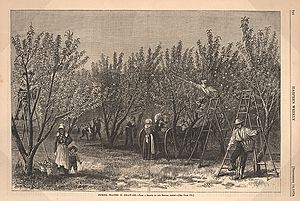
Delaware's farms produce a lot of poultry (like chickens), plants for nurseries, soybeans, dairy products, and corn.
Major Industries and Jobs
Some of the biggest employers in Delaware include:
- Government: The State of Delaware and New Castle County.
- Education: The University of Delaware and Delaware Technical Community College.
- Banking: Large banks like Bank of America and JPMorgan Chase.
- Chemical and Pharmaceutical Companies: Companies like DuPont de Nemours Inc. and AstraZeneca.
- Healthcare: Hospitals and health systems such as ChristianaCare.
- Farming: Especially chicken farming in Sussex County, with companies like Perdue Farms.
- Retail: Stores like Walmart and Walgreens.
Why Companies Choose Delaware
More than half of all publicly traded companies in the U.S. are legally set up in Delaware. This is because Delaware has very business-friendly corporate laws. Taxes from these companies provide about one-fifth of the state's income. There are over a million registered companies in Delaware, which is more companies than people!
Media and News
Newspapers
Delaware has two main daily newspapers. The Delaware State News is based in Dover and covers the southern counties. The News Journal covers Wilmington and northern Delaware. There are also many weekly, monthly, and online publications.
Television
Delaware does not have its own major TV stations. The northern part of the state gets TV channels from Philadelphia. The southern part gets channels from Salisbury, Maryland. Some Philadelphia stations have offices in Delaware to cover local news.
Radio
Many radio stations are licensed in Delaware. Some well-known ones include WDDE 91.1 FM and WDEL 1150 AM in Wilmington, and WDOV 1410 AM in Dover.
Fun Things to Do in Delaware
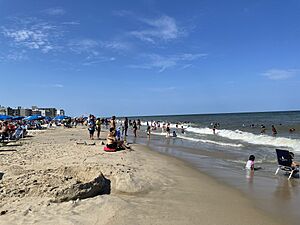
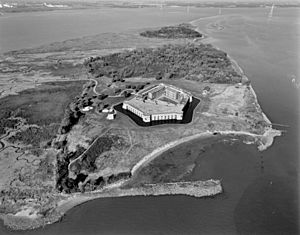
Delaware is home to First State National Historical Park. This park includes historic sites across the state, like the New Castle Court House and Dover Green. The state also has many museums, wildlife refuges, parks, and historic places.
The Delaware beaches are very popular vacation spots. These include Rehoboth Beach, Lewes, Dewey Beach, Bethany Beach, South Bethany, and Fenwick Island. Rehoboth Beach is often called "The Nation's Summer Capital." This is because many people from Washington, D.C., Maryland, and Virginia visit it. Visitors enjoy the town's charm, art, nightlife, and tax-free shopping. Tourism brings in billions of dollars each year for Delaware.
Delaware hosts many festivals and events. Some popular ones are:
- The Riverfest in Seaford.
- The Rehoboth Beach Chocolate Festival.
- The Apple Scrapple Festival in Bridgeville.
- The Clifford Brown Jazz Festival in Wilmington.
- The Sea Witch Halloween Festival in Rehoboth Beach.
- The Firefly Music Festival.
- The Return Day Parade in Georgetown, held after every election.
In 2015, tourism generated $3.1 billion for Delaware. It also provided jobs for over 41,730 people. Most tourists (97%) arrive by car.
Delaware also has two large sports venues. Dover Motor Speedway is a race track in Dover. Frawley Stadium in Wilmington is home to the Wilmington Blue Rocks, a Minor League Baseball team.
Learning in Delaware
In the early 1920s, Pierre S. du Pont helped improve schools in Delaware. He donated four million dollars to build 86 new school buildings, especially for African American children.
Delaware was part of the famous Brown v. Board of Education Supreme Court case. This case led to the end of segregated public schools in the U.S. Delaware was the only state where the court had already ruled that segregation was unconstitutional.
Delaware's education system is quite centralized. This means the state Superintendent of Education has a lot of control. However, local school boards still decide on taxes and some parts of the curriculum. Because of its small size and centralized system, Delaware was the first state to connect every K-12 classroom to the Internet by 1999.
Colleges and Universities
Delaware has several colleges and universities:
- Delaware College of Art and Design
- Delaware State University
- Delaware Technical & Community College
- Goldey-Beacom College
- University of Delaware—This university is highly ranked in the U.S. and worldwide.
- Widener University School of Law
- Wilmington University
Getting Around Delaware
The Delaware Department of Transportation (DelDOT) manages transportation in Delaware. DelDOT handles things like road maintenance, traffic signals, toll roads, and public transportation.
In 2009, DelDOT maintained 89% of the state's public roads. This is much higher than the national average.
Roads and Highways
Interstate 95 (I-95) crosses northern Delaware. There are also other Interstate routes like I-495 and I-295. Six U.S. highways serve Delaware, including U.S. 9, U.S. 13, and U.S. 40. Several state highways also cross Delaware, such as DE 1 and DE 9. DE 1 is a major route connecting Wilmington to the Delaware beaches.
Delaware also has three toll roads:
- The Delaware Turnpike (I-95) between Maryland and New Castle.
- The Korean War Veterans Memorial Highway (DE 1) between Wilmington and Dover.
- The U.S. 301 toll road between the Maryland border and DE 1.
A bicycle route, Delaware Bicycle Route 1, runs the entire length of the state from south to north.
Ferries
Three ferries operate in Delaware:
- The Cape May–Lewes Ferry crosses the mouth of Delaware Bay between Lewes, Delaware and Cape May, New Jersey.
- The Woodland Ferry crosses the Nanticoke River southwest of Seaford.
- The Forts Ferry Crossing connects Delaware City with Fort Delaware and Fort Mott, New Jersey.
Trains and Buses
Amtrak has two train stations in Delaware along the Northeast Corridor: one in Newark and a busier one in Wilmington. SEPTA's local trains also serve stations in northern Delaware.
Freight trains are operated by companies like Norfolk Southern and CSX. There are also smaller local railroads that serve businesses in the state.
The DART First State public transportation system includes buses, subsidized passenger rail, and special services for the elderly and disabled.
Air Travel
As of 2023, Avelo Airlines offers flights from Wilmington Airport to Florida. For most domestic and international flights, Delaware residents often use larger airports nearby. These include Philadelphia International Airport (PHL), Baltimore-Washington International Thurgood Marshall Airport (BWI), and Washington Dulles International Airport (IAD).
Dover Air Force Base is one of the largest air force bases in the country. It is home to large military transport planes. It also serves as the entry point for U.S. military personnel who die overseas.
Sports and Fun
- Professional Teams
| Team | Sport | League |
|---|---|---|
| Delaware Black Foxes | Rugby League | USA Rugby League |
| Delaware Blue Coats | Basketball | NBA G League |
| Delaware Thunder | Hockey | Federal Prospects Hockey League |
| Diamond State Roller Girls | Roller derby | Women's Flat Track Derby Association |
| Wilmington Blue Rocks | Baseball | High-A East |
Delaware does not have its own teams in the major professional sports leagues. So, many people in Delaware follow teams from Philadelphia or Baltimore. The University of Delaware's football team is very popular across the state.
Delaware is home to Dover Motor Speedway, also known as the Monster Mile. It is one of only 10 tracks in the nation to have hosted 100 or more NASCAR Cup Series races. Bally's Dover is a popular place for harness racing (horse racing). It's unique because the horse racing track is inside the car racing track!
Delaware's official state sport is bicycling.
Delaware's International Connections
Sister State
Delaware has a "sister state" relationship with Miyagi Prefecture in Japan. This connection started in 1997. They have had exchange programs for students, which help young people from both places learn about each other's cultures.
Famous People from Delaware
Some well-known people from Delaware include members of the du Pont family, who were important politicians and business leaders. Also, the 46th and current president of the United States, Joe Biden, moved to Delaware as a child. He later represented Delaware for 36 years in the United States Senate before becoming Vice President and then President.
Images for kids
See also
 In Spanish: Delaware para niños
In Spanish: Delaware para niños



